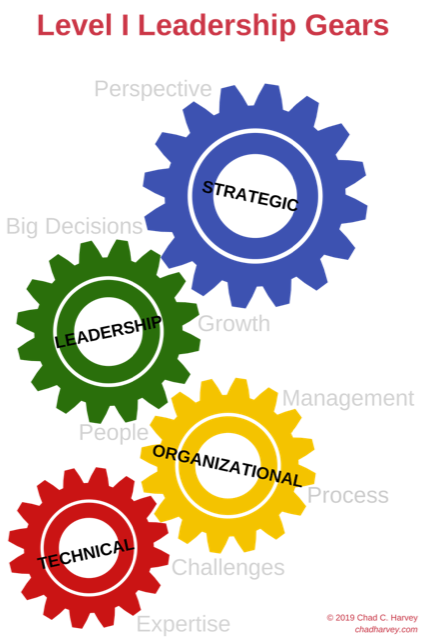Level I Leadership Gears: Time to Shift into Gear

Owners of small to medium-sized businesses (SMB’s) need a simple framework for gauging where they are in their personal development as a leader. That framework must relate to both the individual and the lifecycle of the business because the person and the organization are inextricably linked.
This article, which is part one of a three-part segment, sets forth a simple framework with three transitions and four levels (“gears”) that owners proceed through:
- Technical
- Organizational
- Leadership
- Strategic
I have based these Level 1 Gears on my executive coaching work within and observations of the SMB space. Let’s take a moment to explore what each one entails.
SMB Level 1 Leadership Gears
Technical
The business owner is a subject matter expert (SME) who decided at some point to either begin charging for her services/products or to purchase a business that was related or complementary to her strengths. The business has grown and likely has eight to 15 employees. The owner is involved in all major decisions and often serves as the ultimate source of guidance and technical expertise for all engagement with employees, operating (mostly) as an extension of her will. There may be a management team, but it is in all likelihood not a leadership team.
Organizational
The business has grown (and continues to grow), and the owner has begun codifying processes and structuring a management team. She has one to two managers (most likely promoted from within the organization) and front-line employees no longer report directly to her. She has begun relying more on outside experts (CPA, attorney, digital marketing agency, etc.) and is delegating more of the company’s day-to-day work.
During this period, the owner has likely experienced a few large failures or “blow-ups” pertaining to either: a) products, services, and clients; or b) employees. The owner takes these failures quite personally and has begun to question what she’s doing wrong.
Leadership
The Leadership Gear typically applies to a company that has a larger management team, mostly comprised of home-grown talent with one or two outside hires that have worked in other, similarly sized organizations. “Stuff” is getting done (sort of), but the owner finds that she’s not only spending a lot of time solving problems that her managers bring her, but also that her team can’t solve many of the organization’s challenges. She begins to question how she’s “managing the managers” and whether this team can propel her company to the next level.
Strategic
The Strategic Gear is characterized by the hiring or development of a more experienced, capable, and professional leadership team. The owner now focuses most of the time she previously spent managing the managers on: a) “leading the leaders,” b) facilitating their continued growth and development, and c) helping to set the overall strategy of the organization. The owner also focuses on high-level KPI’s (Key Performance Indicators), and that messy cultural stuff. Additionally, most replicable decisions or actions that were previously treated as one-offs have now been “process-ized.”

Four Important Points About Leadership Gears
- The four Gears are intentionally wide swim lanes that organizations will find themselves in. The employee figures are approximations, and some organizations may find that a Gear level has less or more of both.
- Reaching a specific Gear doesn’t mean that you’ve earned the right to stay in that Gear or that you’ll automatically reach the next one. Some organizations plateau and then backslide. It happens. What matters is that you’re aware of which Gear you’re in and why.
- While the Gears are a hierarchy to be climbed, each Gear must also evolve (to Level 2 Gears). This is critical because your organization will not work unless all Gears continue to spin—and many will spin without the owner’s involvement. For example, the “Technical” Gear never goes away; it evolves and functions at a higher, different level but remains a foundational Gear powering your entire organization. Never forget that.
- The growth of the owner as a leader is intricately linked to the growth of the organization. The two are so firmly attached that when organizations grow to a certain size, the cycle may repeat itself. As new products and services spawn new divisions, units, and silos, the challenge becomes how to either double-shift a new unit to a higher Gear or how to progress that unit more rapidly through the Gears.
Next Stop: Level 2 Gears
In part 2 of this series, we’ll discuss the three shift points to get from one Leadership Gear to the next.
Let me know what you think about this framework. And if you’re having difficulty switching Gears—or figuring out which Gear you’re currently in—give me a call. I love working with passionate leaders.
